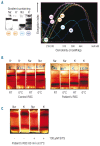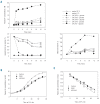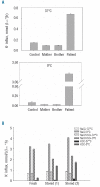Cryohydrocytosis: increased activity of cation carriers in red cells from a patient with a band 3 mutation
- PMID: 20015879
- PMCID: PMC2817020
- DOI: 10.3324/haematol.2009.010215
Cryohydrocytosis: increased activity of cation carriers in red cells from a patient with a band 3 mutation
Abstract
Background: Cryohydrocytosis is an inherited dominant hemolytic anemia characterized by mutations in a transmembrane segment of the anion exchanger (band 3 protein). Transfection experiments performed in Xenopus oocytes suggested that these mutations may convert the anion exchanger into a non-selective cation channel. The present study was performed to characterize so far unexplored ion transport pathways that may render erythrocytes of a single cryohydrocytosis patient cation-leaky.
Design and methods: Cold-induced changes in cell volume were monitored using ektacytometry and density gradient centrifugation. Kinetics, temperature and inhibitor-dependence of the cation and water movements in the cryohydrocytosis patient's erythrocytes were studied using radioactive tracers and flame photometry. Response of the membrane potential of the patient's erythrocyte membrane to the presence of ionophores and blockers of anion and cation channels was assessed.
Results: In the cold, the cryohydrocytosis patient's erythrocytes swelled in KCl-containing, but not in NaCl-containing or KNO(3)-containing media indicating that volume changes were mediated by an anion-coupled cation transporter. In NaCl-containing medium the net HOE-642-sensitive Na(+)/K(+) exchange prevailed, whereas in KCl-containing medium swelling was mediated by a chloride-dependent K(+) uptake. Unidirectional K(+) influx measurements showed that the patient's cells have abnormally high activities of the cation-proton exchanger and the K(+),Cl(-) co-transporter, which can account for the observed net movements of cations. Finally, neither chloride nor cation conductance in the patient's erythrocytes differed from that of healthy donors. Conclusions These results suggest that cross-talk between the mutated band 3 and other transporters might increase the cation permeability in cryohydrocytosis.
Figures



Similar articles
-
A novel erythroid anion exchange variant (Gly796Arg) of hereditary stomatocytosis associated with dyserythropoiesis.Haematologica. 2009 Aug;94(8):1049-59. doi: 10.3324/haematol.2008.002873. Haematologica. 2009. PMID: 19644137 Free PMC article.
-
Monovalent cation leaks in human red cells caused by single amino-acid substitutions in the transport domain of the band 3 chloride-bicarbonate exchanger, AE1.Nat Genet. 2005 Nov;37(11):1258-63. doi: 10.1038/ng1656. Epub 2005 Oct 9. Nat Genet. 2005. PMID: 16227998
-
Hereditary stomatocytosis and cation-leaky red cells--recent developments.Blood Cells Mol Dis. 2009 May-Jun;42(3):216-22. doi: 10.1016/j.bcmd.2009.01.014. Epub 2009 Mar 3. Blood Cells Mol Dis. 2009. PMID: 19261491 Review.
-
Point mutations involved in red cell stomatocytosis convert the electroneutral anion exchanger 1 to a nonselective cation conductance.Blood. 2007 Sep 15;110(6):2158-65. doi: 10.1182/blood-2006-12-063420. Epub 2007 Jun 6. Blood. 2007. PMID: 17554061
-
Cell volume-regulated cation channels.Contrib Nephrol. 2006;152:25-53. doi: 10.1159/000096315. Contrib Nephrol. 2006. PMID: 17065806 Review.
Cited by
-
The Molecular Basis for Altered Cation Permeability in Hereditary Stomatocytic Human Red Blood Cells.Front Physiol. 2018 Apr 16;9:367. doi: 10.3389/fphys.2018.00367. eCollection 2018. Front Physiol. 2018. PMID: 29713289 Free PMC article. Review.
-
Loss-of-function and gain-of-function phenotypes of stomatocytosis mutant RhAG F65S.Am J Physiol Cell Physiol. 2011 Dec;301(6):C1325-43. doi: 10.1152/ajpcell.00054.2011. Epub 2011 Aug 17. Am J Physiol Cell Physiol. 2011. PMID: 21849667 Free PMC article.
-
The GPA-dependent, spherostomatocytosis mutant AE1 E758K induces GPA-independent, endogenous cation transport in amphibian oocytes.Am J Physiol Cell Physiol. 2010 Feb;298(2):C283-97. doi: 10.1152/ajpcell.00444.2009. Epub 2009 Nov 11. Am J Physiol Cell Physiol. 2010. PMID: 19907019 Free PMC article.
-
Cation-leak stomatocytosis in standard schnauzers does not cosegregate with coding mutations in the RhAG, SLC4A1, or GLUT1 genes associated with human disease.Blood Cells Mol Dis. 2012 Apr 15;48(4):219-25. doi: 10.1016/j.bcmd.2012.02.003. Epub 2012 Mar 9. Blood Cells Mol Dis. 2012. PMID: 22406315 Free PMC article.
-
Band 3 missense mutations and stomatocytosis: insight into the molecular mechanism responsible for monovalent cation leak.Int J Cell Biol. 2011;2011:136802. doi: 10.1155/2011/136802. Epub 2011 Aug 23. Int J Cell Biol. 2011. PMID: 21876696 Free PMC article.
References
-
- Bruce LJ, Robinson HC, Guizouarn H, Borgese F, Harrison P, King MJ, et al. Monovalent cation leaks in human red cells caused by single amino-acid substitutions in the transport domain of the band 3 chloride-bicarbonate exchanger, AE1. Nat Gen. 2005;37(11):1258–63. - PubMed
-
- Delaunay J. The hereditary stomatocytoses: genetic disorders of the red cell membrane permeability to monovalent cations. Semin Hematol. 2004;41(12):165–72. - PubMed
-
- Iolascon A, Perrotta S, Stewart GW. Red blood cell membrane defects. Rev Clin Exp Hematol. 2003;7(1):22–56. - PubMed
-
- Gore DM, Layton M, Sinha AK, Williamson PJ, Vaidya B, Connolly V, et al. Four pedigrees of the cation-leaky hereditary stomatocytosis class presenting with pseudohyperkalaemia. Novel profile of temperature dependence of Na+-K+ leak in a xerocytic form. Br J Haematol. 2004;125(4):521–7. - PubMed
-
- Jarvis HG, Chetty MC, Nicolaou A, Fisher J, Miller A, Stewart GW. A novel stomatocytosis variant showing marked abnormalities in intracellular [Na] and [K] with minimal haemolysis. Eur J Haematol. 2001;66(6):412–4. - PubMed
Publication types
MeSH terms
Substances
LinkOut - more resources
Full Text Sources

